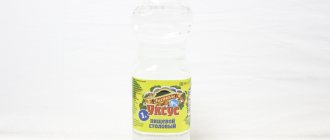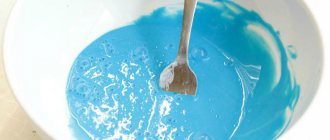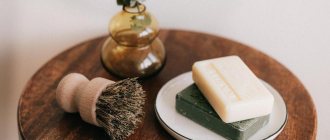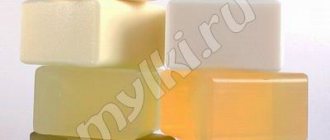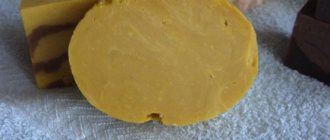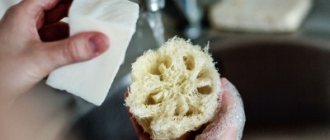Using handmade soap means caring for the health of loved ones: the cosmetic product does not contain harmful chemical impurities or ingredients of unknown origin. You can purchase such a product at a handicraft exhibition, in an online store, or cook it yourself.
Soap from scratch contains alkalis, working with which requires care, accurate calculations and compliance with safety precautions, but the advantage of the product is that it contains no sulfates. Making soap at home from a ready-made base, dyes and flavors is an activity that even a child can handle. In craft stores, where you can find everything you need to create a beautiful and practical gift, you can buy ingredients or various kits.
How to make soap a source of income
Soap making can turn from a hobby into a real profitable business if you bring something unusual to the production of this cosmetic product. Such a highlight will be the original shape, a special smell and additional coloring of the finished product with special paints.
Ordinary blocks of classical shape no longer surprise anyone. But figurines in the form of animals, fruits and various objects, which are difficult to recognize as a regular skin cleanser, attract admiring glances and make you want to buy an interesting thing. To make such figurines, you will need special silicone soap molds. They can be purchased at the store or made yourself.
Popular molds
Silicone molds
Three-dimensional shape in the form of an eared pig. It is even easier to extract finished soap from it, because... it's collapsible.
In appearance, the shapes differ little, but how many soap flowers are cast with their help!
Three-dimensional shape that captures the finest details of each rose petal
Plastic molds
Sheet of molds for chocolate or soap in the form of sweets. The main thing is to use it for only one purpose: either for cooking or for soap making.
The piglet, even though it comes from a two-dimensional shape rather than a three-dimensional one, looks cute.
Mini molds for gift soap in the form of cubes with letters. Words that are made up of these letters are selected individually for a person or holiday (for example, name, profession, year, etc.).
A pig made from a 2D shape is a gift option for the New Year 2022, of which it is considered a symbol.
Pros and cons of using silicone molds
Silicone is convenient because it is much easier and faster to get the finished product out of it, and the molds take up less space than plastic containers. Plastic sometimes has to be heated under running hot water, which negatively affects the outline of the soap figure. A wet and warped cosmetic product loses its appeal.
Cheap silicone soap molds are not easy to find in craft stores, but even the most common ones will cost three times more than plastic ones. As an alternative, soap makers can purchase standard ice or baking molds if they do not plan to create something unusual.
From a plastic bottle
To make homemade multi-layer soap, you can use ordinary plastic bottles. To do this you will need to prepare:
- two bottles of different sizes;
- plastic board;
- plasticine.
Take the plasticine and spread it in an even layer, at least 0.5 cm, on a plastic board. Then cut off the neck and bottom of the bottles. Insert the resulting forms into one another and fix them in plasticine. When pouring soap into a mold, first fill the space between the bottles and let it harden, then remove the small bottle and pour a different color of soap into the empty space. This way you get a two-layer product; if you want to make more layers, then use more bottles of different sizes.
Don't rush to spend money and buy soap molds. You can make them yourself using available materials. In addition to saving money, you will get an original and unique design for your handmade soap. Making such forms does not require much effort or time.
DIY soap mold
Interesting figurines are obtained using silicone 3D soap molds, which allow you to create detailed figures of different sizes. Their only drawback is their very high cost. Not every master is ready to spend a large sum on such a device. It is much more profitable to learn how to make silicone molds for 3D soap yourself, using various materials.
You will need a special super-soft silicone two-component compound with high fluidity, designed for casting. It consists of a base and a hardener. An optional component is a dye for silicones, which will help to stir the mixture evenly. The master model from which the silicone soap mold will be made must be dry and clean.
Application area
Silicone is an organosilicon compound that is actively used in many areas of human life. The substance is especially popular in construction and repair, since it is based on the following:
- sealants,
- adhesive lubricants,
- hydrophobic impregnations,
- primers,
- defoamers,
- adhesives,
- compounds, etc.
Culinary molds are cast from silicone for baking, freezing and storage. Silicone molds are widely used for making jewelry, figurines, and various decorative and creative items. Products made from this elastomer are used in the automotive industry and even in medicine, because it is hypoallergenic, non-toxic and completely safe for health.
Silicone is bioinert, does not react with surrounding surfaces, does not provoke corrosion of metals, can be used at extreme temperatures, in damp rooms and in direct contact with water and chemicals.
Additional materials
The equipment you will need are electronic scales - precise and regular kitchen scales. You should make sure in advance that their readings match. To mix the ingredients, it is convenient to use a large disposable glass, measuring container or mug with a handle.
Plastic containers are not very suitable for making silicone soap molds because they wrinkle. It is better to mix small portions of silicone, weighing up to 100 g, using small plastic knives with cut edges.
The stick for stirring the liquid should be hard and flat. You can make such a tool yourself from a simple ruler with rounded edges. To stir the dye, you should stock up on a long and thin wooden stick. You can collect the catalyst using a regular Pasteur pipette.
To pour a silicone soap mold, you need a hard surface, such as thick cardboard and several sheets of thick paper. The walls of the formwork are created from them. It is more convenient to use paper napkins or towels in a roll; you will need a lot of them. Attach the model to the cardboard base using a glue gun.
Process Features
It is necessary to form a flat pancake from plasticine or putty, which will be laid out on the hard surface of the stand. The thickness of the pancake must be at least half a centimeter so that cylinders made from bottles can be installed in it. Make sure that the cylinders are well fixed, that is, recessed in the putty. A narrow cylinder is installed inside a wide one.
Pour the first part of the soap into the space between the walls of the cylinders and let it harden. After complete hardening, remove the inner narrow cylinder and fill in the second part of the soap. The result is a multi-colored multi-layer soap, which after production can be cut into slices or thin plates. As a rule, this method is well suited for creating soap from glycerin with the addition of various dyes.
Preparing Ingredients
The components for mixing must be kept at room temperature for several hours. Read the manufacturer's instructions carefully. A silicone soap mold can be spoiled by stagnant material, so before use it must be kneaded for several minutes, slowly turning the container over. When using dye, it is better to stir it with a wooden stick so that the pigment does not settle to the bottom.
From sealant
If you want to make your own soap mold from sealant, you will need:
- sealant;
- starch;
- mixing utensils;
- knife;
- gloves.
You will also need an item whose shape you want to repeat. Take a plastic bowl, having previously covered its bottom with cling film or a plastic bag, and pour a cup of starch into it. Pour a tube of silicone sealant into it and start mixing. The result should be a homogeneous mass resembling plasticine.
Then roll the resulting mass into a ball. Place the selected item in it and press it tightly with your fingers. It is important that there are no voids left inside. Leave the mixture for 2-3 hours, then remove the item. You can already pour soap into this mold.
Read also: How to make laundry detergent from laundry soap?
We update the interior with our own hands
How to properly dry flowers for a herbarium
Making a silicone mold
Making a silicone mold consists of the following steps:
- Glue the model to the base using a glue gun.
- We make formwork for pouring using cardboard or thick paper: leave a gap of 5-10 mm between the model and the walls, depending on the size of the model, and glue it to the base, then connect the edges.
- Pour the main component into a separate container, measuring out the required amount, according to the manufacturer’s recommendations.
- Add a little dye.
- Having reset the scale, we measure the catalyst and connect it to the base.
- Stir the mixture thoroughly for a minute until smooth.
- Pour the silicone evenly into the mold and wait for it to completely harden.
You can remove a simple model a few hours after pouring by separating the mold from the base with a sharp knife. Then you should disassemble the formwork. It is better to remove complex models after a day. All that remains is to carefully trim the edges and the form is ready. Now you can start making unusual soap as a gift or for sale.
Original recipes
Soap molds can also be created from sealant, which is applied in thin layers to the surface of any plastic mold. It should be remembered that there must be at least 12 layers to obtain a durable form, and the next layer is applied only after the previous one has dried. It is advisable to choose an odorless sealant, but it is better to use it to create forms in the fresh air, for example, on a balcony. It is advisable to use hard surfaces as a stand, for example, a plastic cutting board that you don’t mind scratching. After complete hardening, the mold can be easily separated from the stand using a thin knife or scissors.
In fact, the imagination of soap makers is inexhaustible, and over time you will come up with your own original ways of creating colorful soap molds.
The role of silicone in our life
Silicone has become the main material of the 21st century.
He is present in our lives much more than we think. Silicone is used in industry. manufacturing, space and automotive industry, repair and construction (sealing), medicine (contact lenses), cosmetology (care products, injections), cooking (potholders, molds) and electronics. Properties of silicone
A group of synthetic silicone polymers has many beneficial qualities for humans. The main one is inertia. Silicone itself does not have any effect, it only forms a thin breathable film.
Silicone:
- Elastic;
- Resistant to deformation;
- Has light weight;
- Lasting;
- Does not stick (no adhesion);
- Has minimal shrinkage;
- Does not transmit heat or electricity;
- Chemically inert;
- Easy to care for;
- Does not promote bacterial growth;
- Has a long service life.
These properties of silicone make it a versatile material for a wide range of jobs.
